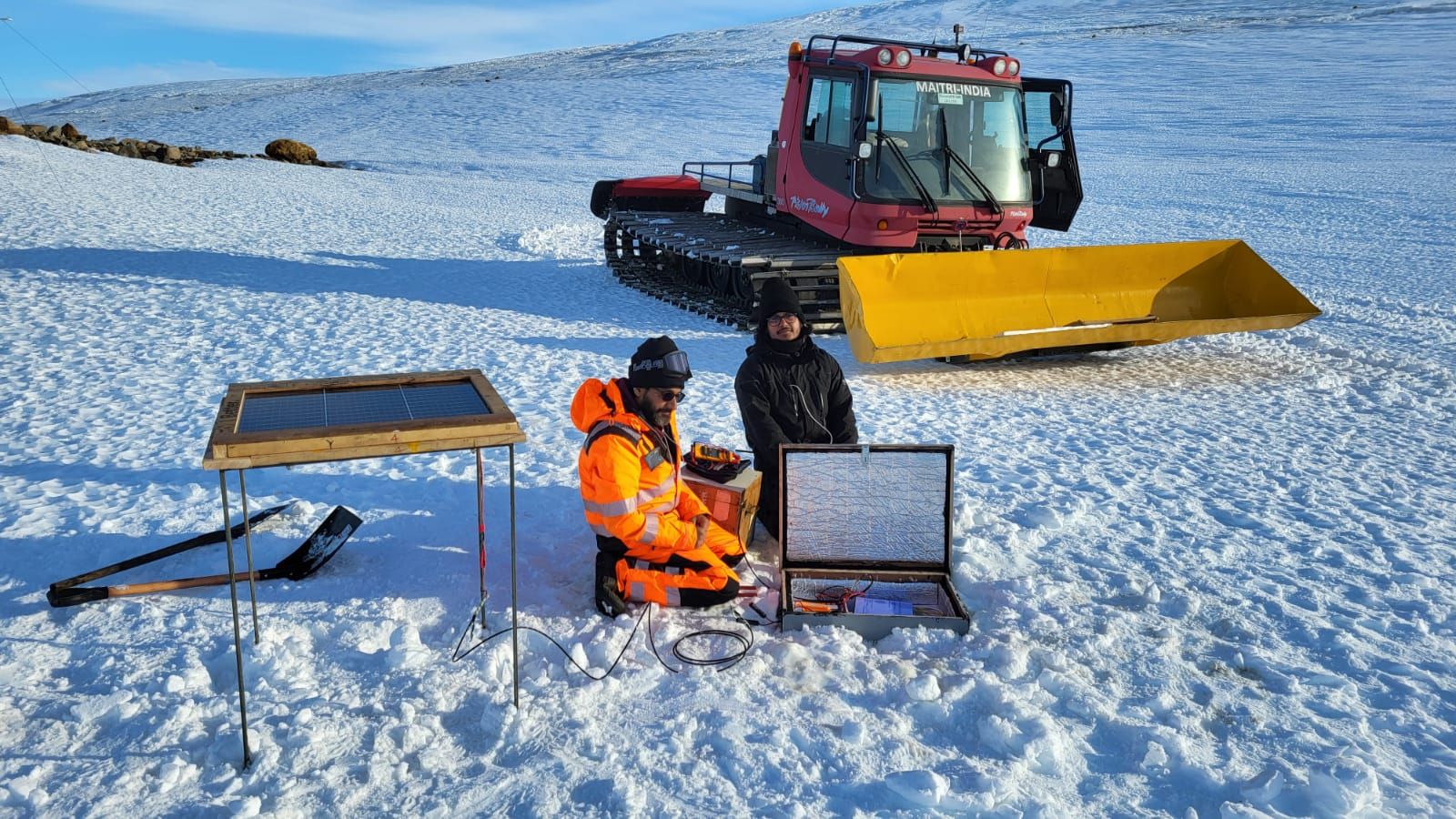
Caption: Seismometer (designed by IITR) being deployed in Antarctica by NCPOR (in figure: Ariz Ahmed)
Seismic
monitoring in Antarctica
One of our seismometer prototypes, which we developed in-house in our lab, was installed in Antarctica for testing.
The deployed instrument plays a
vital role in:
🔹 Monitoring icequakes and
ice-shelf movement
🔹 Studying the impacts of climate
change in this fragile ecosystem
Caption:
Seismometer (designed by IITR) being deployed in Antarctica by
NCPOR (in figure: Ariz Ahmed)
Expedition
by PhD student (Rinku) for deploying Ocean Bottom Seismometer
To investigate the origin of the geoid low, a team of scientists from National Center for Polar and Ocean Research (NCPOR), Goa, along with students from various institutes, embarked on the Ocean Research Vessel, Sagar Nidhi. The team deployed 18 Ocean Bottom Seismometers (OBS) in an array, positioned around the IOGL anomaly located south of the Indian subcontinent.
Caption: (a) OBS just before deployment, (b) Rinku beside the OBS named after his initials (T11-RM)
Report on
Field Trip to Uttarkashi
Date:
4th - 6th February, 2023
Target:
Installation of Raspberry Shake seismometer in three locations
of Garhwal region.
Team
members:
Navneet Kumar Srivastava and Rinku Mahanta
Supervisor: Prof. Vipul Silwal
Department
of
Earth Sciences, IIT Roorkee.
The Raspberry Shake (RS) stands as the most compact
seismograph of its class globally, capable of detecting
earthquakes spanning from minuscule tremors imperceptible to
humans to the formidable seismic events occurring worldwide.
There are three variants of RS seismographs:
• Raspberry Shake 1D:
Equipped with a single Vertical Velocity Seismometer, adept at
recording Up-Down Ground Motion Activity.
• Raspberry Shake 3D:
Outfitted with three Vertical & Lateral Velocity Sensors,
capable of capturing both Up-Down and Side-to-Side Activity.
• Raspberry Shake 4D:
Features a Vertical Velocity Seismometer along with three
Vertical & Lateral Accelerometer Sensors, ensuring
comprehensive coverage for earthquakes across all magnitudes.
On February 4, 2023, a team comprising Navneet Kumar
Srivastava and Rinku Mahanta embarked on a mission to install
three Raspberry Shakes at predetermined locations within
Uttarakhand's Garhwal Himalaya. These locations were chosen
based on the availability of power supply for the instruments
and mobile network coverage. Mobile network connectivity is
crucial for the instruments, enabling the retrieval of live
data through SIM cards inserted into connected dongles. Each
instrument was safely enclosed within its respective wooden
box for protection. The team successfully completed their
fieldwork and returned to Roorkee on February 6.
The
description of the places are given below:
Caption:
Location of the stations (RS) of three places of Uttarakhand.
Caption: Installation of instrument R0053 in Chinyalisaur |
Instrument
1: Location
1
- Chinyalisaur Device
Name
- R0053 - RS4D Lat-
30.58928 Long
- 78.32070 Elevation
-
1038 Device
facing
north (difference in degrees) - 2 SIM
Card
number - 7895113733 Device
status
- Running |
Caption:
Installation of instrument R264B in Maneri Dam. |
Instrument
2: Location
2
- Maneri Dam Device
Name
- R264B - RS3D Lat-
30.73935 Long
- 78.52896 Elevation
-
1445m Device
facing
north (difference in degrees) - 2 SIM
Card
number - 7983960459 Device
status
- Running Service
provider - Jio |
Caption: Installation of instrument RF532 (by Navneet Srivastava) in Bhatwari. |
Instrument
3: Location
3
- Bhatwari Device
Name
- RF532 Lat-
30.8071 Long
- 78.6191 Elevation
-
1538 Device
facing
north (difference in degrees) - 2 SIM
Card
number - 8979492523 Device
status
- Running Service
provider - Airtel
|